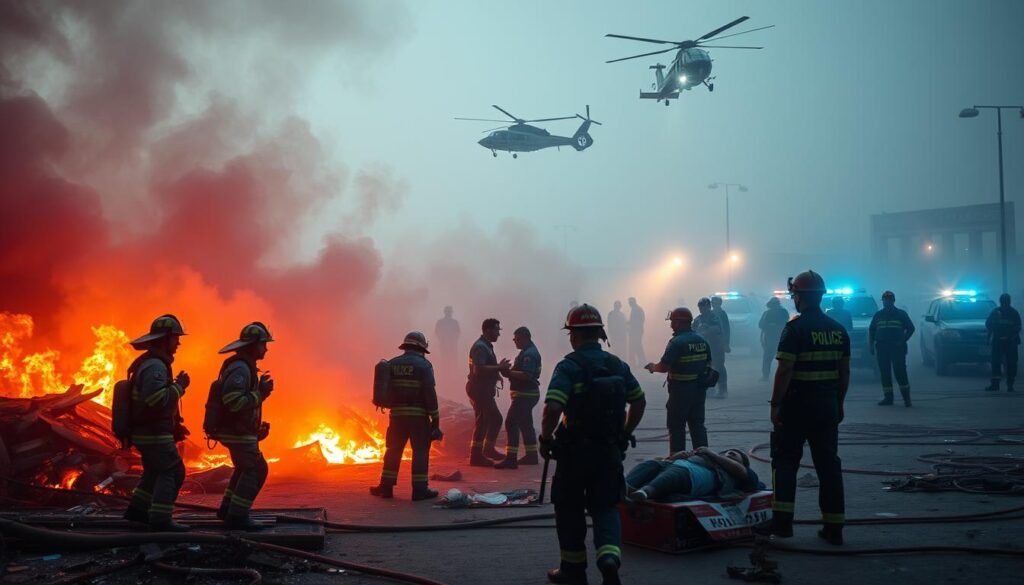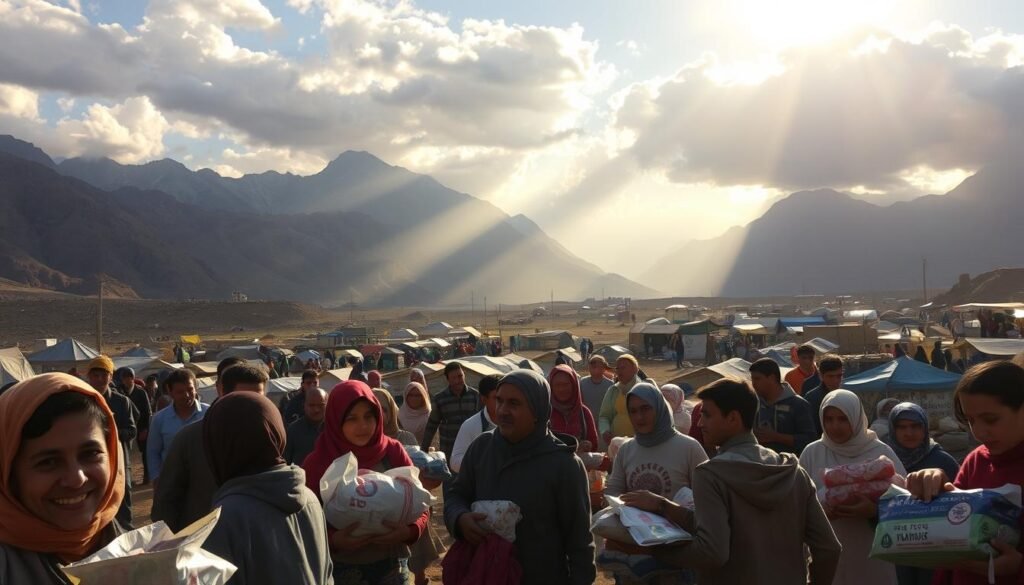How do global efforts help millions facing crises every day? From conflict zones to disaster-stricken regions, coordinated support saves lives and rebuilds communities. Millions rely on these initiatives for food, shelter, and medical care.
In 2014 alone, over 2.8 million people in Iraq needed food assistance, while 800,000 required emergency shelter. Organizations like the UN’s OCHA and CERF work together to deliver urgent help. Their focus spans food security, health services, and disaster recovery.
Challenges remain high in regions like Sub-Saharan Africa, the Middle East, and Asia. Yet, collective action ensures vulnerable populations receive critical resources. These efforts strengthen resilience and foster long-term stability.
Key Takeaways
- Millions depend on aid for survival during crises.
- Multi-agency coordination improves response efficiency.
- Food, shelter, and health services are top priorities.
- Regions like Africa and the Middle East face ongoing challenges.
- Global partnerships enhance disaster recovery efforts.
The Global Impact of Humanitarian Aid Projects
Critical relief reaches vulnerable populations in war-torn and disaster-hit regions. Teams work tirelessly to deliver supplies and services where they’re needed most, often in high-risk environments.

Addressing Food Insecurity in Conflict Zones
In Mozambique, community activists partnered with the World Food Programme (WFP) to refer 550 malaria cases for treatment. Such efforts highlight the link between food security and health in unstable areas.
Active war zones like Syria and Yemen face unique hurdles. Blockades and violence often delay food deliveries, leaving families without meals for weeks.
Emergency Shelter and Winter Relief Efforts
UNHCR upgraded tents in Iraq’s Warga Dalal camp with insulated floors and walls before the 2014 winter. These modifications protected thousands from freezing temperatures.
Climate-related disasters have spiked shelter need by 22% since 2020. Organizations now prioritize durable materials for rapid deployment.
The Central Emergency Response Fund (CERF) allocates $150M annually for crises. Its quick disbursements support emergency response in over 40 countries.
Key Organizations Leading Humanitarian Efforts
From UN offices to grassroots NGOs, collaborative action shapes effective disaster response. These groups deploy teams and resources to crisis zones, ensuring timely implementation of life-saving programs. Their coordinated efforts bridge gaps in food security, health care, and shelter.

UN Agencies: Coordinating Global Relief
The World Food Programme (WFP), headquartered in Rome, operates in 83 countries—far surpassing smaller NGOs in scale. Meanwhile, UNICEF and OCHA, based in New York, focus on child welfare and emergency coordination. OCHA’s Inter-Agency Standing Committee streamlines partnerships among 18 global organizations.
Grassroots NGOs Making Local Impact
AMI Foundation trained 30 Mozambican health workers, reaching 64,578 beneficiaries through community partnerships. In the U.S., Samaritan’s Purse rebuilt homes after Hurricane Helene and ran medical units in Liberia. Their work highlights how local action complements large-scale efforts.
Regional Humanitarian Aid Projects
Different regions face unique challenges that demand tailored solutions. Cultural, environmental, and political factors shape how support reaches those in need. From food shortages to natural disasters, local conditions dictate the strategies used.

Sub-Saharan Africa: Health and Food Security
In Guinea-Bissau, AMI trained midwives for 293 safe births, while UNFPA’s regional offices scaled maternal care. Nutrition programs also vary—WFP provides school meals, whereas AMI focuses on agricultural training.
The Democratic Republic of Congo battles both conflict and malnutrition. Local partners work at the national level to distribute seeds and tools, empowering farmers.
Middle East: Refugee Support in Iraq and Syria
Iraq hosts 1.2 million internally displaced people and 250,000 Syrian refugees. UNHCR’s 2014 operations served 2.8 million with shelter and medical care. In Syria, project delays occur due to active conflict zones.
Asia: Disaster Recovery in Sri Lanka and Bangladesh
Sri Lanka rebuilt after Cyclone Idai while adapting to COVID-19. AMI’s 2019-2020 project repaired homes and clinics. In Bangladesh, WFP and volunteers teamed up to feed flood survivors in remote locations.
Focus on Health and Emergency Response
Health crises demand swift, targeted interventions to protect vulnerable populations. From maternal care to pandemic response, tailored programs address urgent needs while adapting to challenges like conflict or disease outbreaks.

Sexual and Reproductive Health Initiatives
AMI Foundation conducted 108 youth sessions in Uganda, leading to 375 referrals for sexual reproductive health services. In Guinea-Bissau, their work included vaccinating 500+ children and training midwives for safer births.
UNFPA supports regional hubs in Cairo and Bangkok, focusing on women’s health. Their efforts include distributing menstrual kits to 45,000 Syrian refugees, ensuring dignity and prevention of infections.
COVID-19 Adaptations in Aid Delivery
Telemedicine use surged from 12% to 89% during the pandemic, expanding health services in remote areas. AMI shifted to virtual partner meetings, maintaining support despite lockdowns.
WHO coordinated COVID-19 responses across 72 countries, while local teams adapted clinics for social distancing. These changes highlight the resilience of global health networks.
How Volunteers and Communities Drive Change
Local action fuels global change when communities unite to address crises. From disaster response to health education, grassroots efforts amplify impact where it’s needed most.
Training Local Leaders and Health Workers
Organizations like AMI Foundation train community leaders to tackle urgent needs. In Mozambique, 30 activists learned to identify malaria cases, linking 550 patients to care.
Globally, 225,000 teachers and 84,000 pastoral leaders received hygiene training. These efforts ensure skills stay within communities long after volunteers depart.
Grassroots Advocacy and Youth Engagement
Young people are reshaping crisis response. In Uganda, 14,728 teens joined sexual health programs, while Sri Lankan communities led rebuilding after Cyclone Idai.
Samaritan’s Purse relies on 9,000+ year-round volunteers. Their mission includes processing aid in the U.S. and running clinics abroad.
At the Atma IDP camp, one counselor supports 120 families weekly—proof that local ownership transforms recovery.
Conclusion
Global efforts bring hope to millions by addressing urgent needs like clean water, medical care, and shelter. Collaborations between groups like AMI, WFP, and Samaritan’s Purse have impacted over 64,000 lives, proving the power of united action.
Innovation is key. CERF’s 72-hour funding model speeds up crisis response, while 83% of frontline workers seek mental health training to better serve communities. Future solutions like AI-driven assessments and drone deliveries could revolutionize support systems.
Every contribution counts. Just $6 helps train a teacher through programs like The Greatest Journey, creating lasting change. Together, we can ensure access to vital resources for those who need them most.
FAQ
How do relief efforts help with food insecurity in conflict zones?
Organizations like WFP provide emergency food supplies, cash assistance, and nutrition programs to vulnerable families in war-torn regions. They work with local partners to ensure access to meals and long-term food security.
What role do UN agencies play in global relief operations?
Agencies such as UNICEF and OCHA coordinate life-saving support, from clean water to medical care. They also advocate for policies that protect displaced communities and children in crisis areas.
Why is sexual and reproductive health critical in emergency response?
Women and girls face higher risks during crises. Providing hygiene kits, maternal care, and prevention education ensures safety and dignity, especially in displaced populations.
How do local volunteers contribute to disaster recovery?
Trained community members deliver supplies, run education campaigns, and support rebuilding efforts. Their knowledge of the area speeds up response times and builds trust.
What adaptations were made for COVID-19 in aid delivery?
Teams shifted to contactless distributions, virtual training for health workers, and hygiene awareness programs. Mobile clinics also expanded to reach remote locations safely.
Which regions receive the most focus for long-term development?
Sub-Saharan Africa and South Asia often prioritize health services and food security, while the Middle East focuses on refugee support. Each region’s needs guide tailored solutions.



